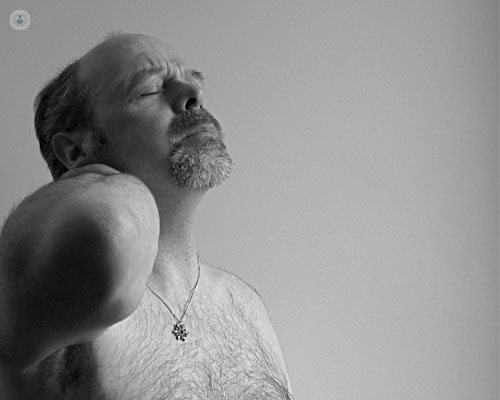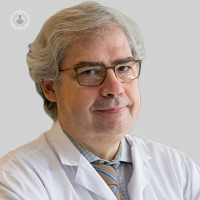Disfagia, ¿qué altera mi deglución?
Written by:Swallowing is a very complex process that we normally learn in childhood and we forget about it until we have a problem when we are older, or when we have a pathology that causes it. It really is the process that takes food from the table to the stomach. There are several phases, the first phase is that the food is introduced into the oral cavity and the oral cavity is prepared by chewing the instillation and transformation of a solid bolus into a textured bolus, as if it were a puree that later progresses through the tongue to the throat, to the pharynx. This process already has a series of imbrications with movements of the tongue, movements of the pharynx, movements of the lips, movement of the facial muscles and movement of the jaw, which are going to be preparing the bolus.
During this phase, which is voluntary, can be interrupted at will if any alteration occurs. After this, the sphincter that separates the veil from the palate of the pharynx is opened and the bolus is propelled to the pharynx where it accumulates and is squeezed downwards reaching the esophagus to begin the esophagus process of swallowing. During this second pharyngeal phase of swallowing it is important to protect the airway because there is a time when the airway and the digestive tract. The larynx, which is the gateway to the lungs, has to be completely closed and protected to prevent the passage of this food into the lungs that would cause major complications, safety complications and pneumonia and lung infections, which would in many cases to the death of the patient. That is why the process of swallowing is very complex. Many pairs of muscles are involved, many cranial nerves and a great deal of neurological and respiratory coordination.
Dysphagia really is the process of alteration in this mechanism of swallowing. There is subjective dysphagia, which the patient thinks he can not swallow, and there is objective dysphagia in which it is really confirmed that the patient can not swallow. It can happen that he can not swallow because he is not able to ingest the food or it may happen that the disorder is that the food passes to the lungs. We would then talk about safety complications against efficacy complications that would only occur initially when the patient is not able to swallow enough food.

The mechanism by which dysphagia occurs is very complex and very varied. Dysphagia really is a symptom that affects patients with many diseases. Patients with neurological problems, the most frequent are cerebral infarctions or cerebrovascular disease, complications of neurodegenerative diseases, Parkinson's disease, multiple sclerosis, amyotrophic lateral sclerosis or neuromuscular diseases, such as myasthenia gravis or certain myopathies, or also occurs in case of diseases or direct pathology of the upper digestive tract. For example, as a result of tumors of the upper digestive tract or as a result of the treatment of these tumors, either by surgery or by chemo or radiotherapy. Chemo or radiotherapy produces many deduction disorders, just as surgery also tends to produce swallowing disorders in this type of patients. Each time we use surgical techniques less aggressive for the physiology and we obtain better functional results in case of these patients.
As for the way to treat dysphagia depends a lot on the cause. As I said before, dysphagia is a symptom, a symptom that can be a consequence of many disorders. A laryngeal locking mechanism disorder, a disorder in the opening of the esophagus, may cause the patient to not swallow. The treatment of each should be individualized. Dysphagia does not have a single treatment, it has different possible treatments that combine according to the physiology and pathophysiology of each case and each patient.
How can dysphagia be prevented?
When we have a patient with dysphagia in the first place we must find out and determine what is the cause of dysphagia. The disease that produces it, if we can find out what it is. Sometimes it is directly the disease that brings us to the patient consultation. We have to inquire about the mechanism that causes dysphagia in that patient and with all these data to consider how we treat it.

The treatment can be of several forms and often these forms are combined. One of them is rehabilitation. The rehabilitation performed by speech therapists allows us to find methods that overcome the problem that patient has when swallowing. Maneuvers that boost certain muscles, exercises that boost certain muscles, maneuvers that produce better safety and prevent food from going to certain positions. For example, patients who have a vocal cord paralysis, with the head rotating toward that paralyzed cord, are able to swallow better by diverting the bolus to the healthy side. At other times it is not just the rehabilitation but the type of diet change. The texture of food is very important. More liquid foods in neurological patients tend to cause more safety disorders and more risk of pneumonia. In those cases they use thickeners or gelled waters, what they are going to do is to enhance the defense mechanism that has the patient with greater textures. Sometimes in patients with more organic dysphagia and who have more disorder with solids, we would try to make a more liquid food that allows that bolus to swallow better.
In short, it is looking for what type of food, with the exploration maneuvers that we can perform, will allow swallowing and working in a more effective and safer way. On rare occasions, but sometimes, there may be certain surgical procedures that could help relieve swallowing disorders.
Why is it hard for me to swallow?
If the patient wonders why it is difficult for him to swallow, it is really because he has altered any of the mechanisms of swallowing. Well the oral phase, and the patient is not able to prepare the bolus in the oral cavity, or propel it from the mouth to the pharynx. Well the pharyngeal phase, that the patient is not able to propel the bolus of the pharynx into the esophagus, which is the mechanism by which it will pass directly from the esophagus to the stomach. Or because that bolus can be passed to the larynx and cause a safety disorder with risk of pneumonia. Any alteration in the mechanisms of physiological swallowing may cause the patient to be unable to swallow. What we have to do in these cases, through instrumental explorations with videoendoscopy swallowing or videofluoroscopy, determine where the cause or causes that cause the patient can not swallow.



